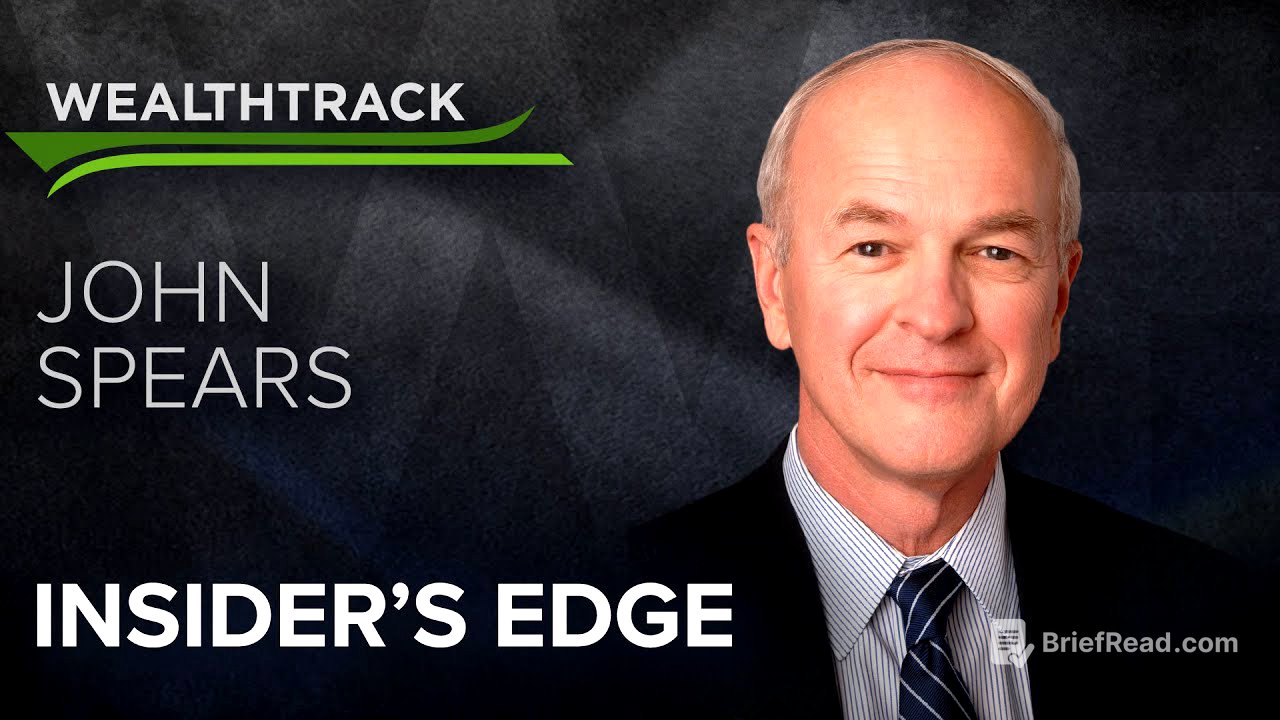TLDR;
John Spears from Tweedy, Browne discusses the firm's new Insider and Value ETF (COPY), which focuses on undervalued companies with insider buying and share buyback programs. The decision to launch the ETF was influenced by empirical research showing that copying insiders in combination with value characteristics can lead to significant market outperformance. Spears also highlights the importance of differentiating between genuine insider buying and buying due to compensation requirements, as well as the significance of share buyback programs. He also shares his insights on the current state of the US and international markets, advocating for international value investments given their attractive valuations.
- Tweedy, Browne launched its first ETF, COPY, focusing on insider buying and share buybacks.
- Empirical research supports the strategy of copying insiders combined with value characteristics.
- International markets, particularly European value stocks, offer more attractive valuations compared to the US market.
Introduction to Tweedy, Browne and the New ETF [0:42]
Consuelo Mack introduces Tweedy, Browne, a 105-year-old investment firm with a strong history in value investing, tracing back to Benjamin Graham and Warren Buffett. The firm has launched its first ETF in 15 years, the Tweedy, Browne Insider and Value ETF (COPY). This ETF focuses on undervalued companies where management is actively buying company stock or engaging in stock buyback programs. John Spears, a managing director and member of the Investment and Management Committees at Tweedy, Browne, explains the rationale behind the ETF's focus on insider buying and share buybacks.
Empirical Research and the Rationale Behind the ETF [3:00]
John Spears explains that the launch of the ETF was largely motivated by empirical research, particularly the work of Professor Seyhun at the University of Michigan, whose study showed that copying insiders, combined with low price-to-earnings and price-to-book ratios, resulted in significant market outperformance. Tweedy, Browne conducted its own study from 1996 to 2022, which confirmed these findings across various countries. The ETF is designed to provide clients with a tax-efficient way to invest in this strategy, with over $30 million of the firm's own money invested in it.
Differentiating Genuine Insider Buying [6:02]
Spears explains the importance of distinguishing between genuine insider buying and buying that is required due to compensation agreements. The firm checks annual reports to see if executives are required to own a certain amount of stock relative to their income. Only "free will" purchases, where executives buy stock beyond their required ownership, are considered significant. These voluntary purchases indicate that the insiders believe the stock price will increase.
Example of a Stock that Made the Cut: UnitedHealth [7:45]
Spears uses UnitedHealth as an example of a company that recently entered the COPY ETF. The former CEO bought $25 million worth of stock at around $290 a share, while the CFO and other insiders also made significant purchases. This "cluster buying," combined with the company's high valuation score (selling at 11 times earnings, resulting in a 9% earnings yield), strong growth, and high return on capital employed, made it an attractive investment. Additionally, Berkshire Hathaway and Appaloosa have also bought positions in UnitedHealth.
The Role of Stock Buyback Programs [9:48]
Spears discusses the importance of stock buyback programs as an indicator. The firm is conducting more research on share buybacks, but initial findings suggest that buybacks, combined with good value scores and no contrary signals from insider selling, correlate with excess returns over the next 12 months. However, if insiders are selling their own shares into the buyback program, it is considered a mixed signal.
Portfolio Construction and Turnover [11:25]
The ETF holds about 200 companies to mimic the characteristics of the empirical studies, where every stock has an equal weighting. The portfolio is actively managed, with a tendency to phase out stocks held for two years, unless they have been reinstated due to continued insider buying or strong scores. The computer calculates over 30 different ratios for every stock daily to determine its score.
Key Indicators and the "Secret Sauce" [13:20]
Spears mentions that the score includes dividend yield, share buyback yield, price-to-earnings ratio, and price-to-tangible book value, among many other factors. While he cannot reveal the exact formula, he notes that it incorporates value factors and measures of stability. However, stability alone does not guarantee excess returns.
Additional Indicators and the Importance of Common Sense [14:05]
Spears states that they haven't found any other empirical indicators as significant as insider buying and stock buybacks. He emphasises the importance of common sense and understanding business valuations, drawing on the firm's experience in leveraged buyouts. He also notes that momentum, or stocks that have performed well in the past, can be a factor, particularly in industries like pharmaceuticals with pricing power.
Example of a Stock that Didn't Make the Cut [16:22]
Spears provides an example of a company that had insider buying and a good value score but was ultimately rejected. Despite multiple insiders buying shares, the CEO's stock ownership was minimal relative to his high salary. Additionally, the company made an acquisition with a low after-tax yield on the purchase price, and lacked transparency in segment reporting. These factors led the firm to pass on the investment, deeming it "too hard."
Valuation of the US Market and International Opportunities [18:54]
Spears discusses the high valuation of the US market, noting that the price-to-book ratio for the S&P 500 is at a record high. He references a chart from J.P. Morgan Asset Management showing that when the P/E of the S&P 500 is above 21 (currently at 28), forward returns are often low or negative. He suggests looking at international markets, particularly European value stocks, which offer more attractive valuations with higher dividend yields and lower P/E ratios.
Staying the Course with Value Investing [21:36]
Spears addresses the challenges of maintaining a value investing approach during a period of US market outperformance and international value lagging. He emphasises the importance of believing in the long-term benefits of buying undervalued assets, citing the common-sense principle that a higher earnings yield is more desirable.
Investment Recommendation and Closing Advice [22:45]
Spears suggests considering an MSCI European value ETF as a potentially interesting addition to a long-term diversified portfolio, given the current market conditions. He highlights the tax efficiency of ETFs in rebalancing and avoiding capital gains taxes. He concludes by sharing the best investment advice he ever received from Benjamin Graham: buy at a discount, recognising the difference between a stock's market price and its intrinsic value.









